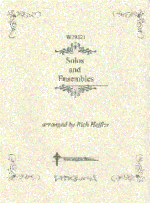-
Amazing Grace
$5.95Moving and affective this solo begins unaccompanied and then later joined by the piano in a Celtic style. A second statement of the tune is further embellished and gains more complexity as it progresses. After a brief modulation the solo line becomes more plaintive- even though still embellished. The Coda is based on a brief motif where it ritards into a gentle repose.
-
Amazing Grace
$5.95Moving and affective this solo begins unaccompanied and then later joined by the piano in a Celtic style. A second statement of the tune is further embellished and gains more complexity as it progresses. After a brief modulation the solo line becomes more plaintive- even though still embellished. The Coda is based on a brief motif where it ritards into a gentle repose.Unusual, emotive and restrained version of the Luther classic The introduction in the piano is presented in an embellished fashion. The solo states the theme in a straight-forward manner. After a brief interlude the solo continues in a different register. Another brief interlude and the soloist continue in a more ornamented manner this time. The piano now states the theme in strong block chords while the solo is very active as an obbligato. Both voices present thematic materials taken from the opening sections. The Coda gives a motivic statement of the opening theme and resolves to a solemn end.
-
Amazing Grace
$5.95Moving and affective this solo begins unaccompanied and then later joined by the piano in a Celtic style. A second statement of the tune is further embellished and gains more complexity as it progresses. After a brief modulation the solo line becomes more plaintive- even though still embellished. The Coda is based on a brief motif where it ritards into a gentle repose.
-
Amazing Grace
$5.95Moving and affective this solo begins unaccompanied and then later joined by the piano in a Celtic style. A second statement of the tune is further embellished and gains more complexity as it progresses. After a brief modulation the solo line becomes more plaintive- even though still embellished. The Coda is based on a brief motif where it ritards into a gentle repose.
-
Amazing Grace
$5.95Moving and affective this solo begins unaccompanied and then later joined by the piano in a Celtic style. A second statement of the tune is further embellished and gains more complexity as it progresses. After a brief modulation the solo line becomes more plaintive- even though still embellished. The Coda is based on a brief motif where it ritards into a gentle repose.
-
Amazing Grace
$5.95Moving and affective this solo begins unaccompanied and then later joined by the piano in a Celtic style. A second statement of the tune is further embellished and gains more complexity as it progresses. After a brief modulation the solo line becomes more plaintive- even though still embellished. The Coda is based on a brief motif where it ritards into a gentle repose.
-
Amazing Grace
$5.95Moving and affective this solo begins unaccompanied and then later joined by the piano in a Celtic style. A second statement of the tune is further embellished and gains more complexity as it progresses. After a brief modulation the solo line becomes more plaintive- even though still embellished. The Coda is based on a brief motif where it ritards into a gentle repose.
-
-
-
-
-
-
-
-
-
-
-
-
-
-
-
All Hail The Power DIADEM
$39.95This is a unique arrangement of “All Hail the Power” that included figures that sound like Beethoven wrote the music. Churches love this setting for its special character and strong interesting musical “feel” as a Beethoven orchestra piece. Created
-
Leaning On The Everlasting Arms
$5.50This solo begins with a easy lilt underpinned by a gentle accompaniment. Moving into the second section of the piece the tune is embellished in a variation format of chromatic triplets. It repeats back to the first section and proceeds to a Coda section- again, in a triplet format.
-
It Is Well With My Soul
$5.50Traditional setting, slightly contemporary- begins with piano in a motif of the theme. The first section is a stylized rendition of the theme. Then, it continues in the chorus much the same. A transition becomes freer in rhythm and harmony. It then repeats back to the opening sections and then moves to the coda where the piece ends in a solemn fashion.
-

